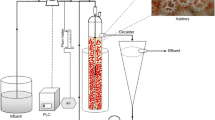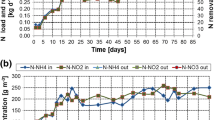Abstract
This paper presents a methodology for the determination of reaction rate constants for nitrifying bacteria and their mean population percentage in biomass in an alternating oxidation ditch system. The method used is based on the growth rate equations of the ASM1 model (IWA) (Henze et al. in Activated sludge models ASM1, ASM2, ASM2d, and ASM3. IWA Scientific and Technical Report no. 9, IWA Publishing, London, UK, 2000) and the application of mass balance equations for nitrifiers and ammonium nitrogen in an operational cycle of the ditch system. The system consists of two ditches operating in four phases. Data from a large-scale oxidation ditch pilot plant with a total volume of 120 m3 within an experimental period of 8 months was used. Maximum specific growth rate for autotrophs (μ A) and the half-saturation constant for ammonium nitrogen (K NH) were found to be 0.36 day−1 and 0.65 mgNH4–N/l, respectively. Additionally, the average population percentage of the nitrifiers in the biomass was estimated to be around 3%.




Similar content being viewed by others
Abbreviations
- V :
-
Volume of each ditch, (m3)
- θ c :
-
Sludge retention time, (day)
- θ :
-
V/Q = hydraulic retention time, (day)
- Q in :
-
Influent wastewater flow rate, (m3/day)
- Q eff :
-
Effluent wastewater flow rate, (m3/day)
- Q w :
-
Waste sludge flow rate, (m3/day)
- t c :
-
Total time length of one cycle, (min or day)
- t n :
-
Nitrification time per tank, (min or day)
- t d :
-
Denitrification time per tank, (min or day)
- t c :
-
2t n + 2t d
- α :
-
tn/tc nitrification time fraction
- r gn :
-
Growth rate of nitrifiers, (mg/l min)
- r n :
-
Nitrification rate, (mg/l min)
- Rgn :
-
Average growth rate of nitrifiers, (mg/l min)
- R n :
-
Average nitrification rate, (mg/l min)
- b A :
-
Autotrophic decay rate, (day−1)
- Y A :
-
Yield constant for autotrophic organisms (nitrifiers), (gr cell COD formed/gr N oxidized)
- μ A :
-
Maximum specific growth rate of autotrophs, (day−1)
- K NH :
-
Half-saturation constant for NH4–N, (mg NH4–N/l
- K OA :
-
Saturation constant for oxygen during aerobic growth of autotrophs, (mg O2/l)
- M n :
-
Mass of nitrified nitrogen (NH4–N converted to NO x –N), (mg/cycle)
- Mgn :
-
Mass of produced nitrifiers in the system, (mg/cycle)
- ΤΝin :
-
Total influent nitrogen (ΤΝin = SNHin + SNoin + SNOxin), (mg/l)
- ΤΝout :
-
Total effluent nitrogen, (mg/l)
- ΤΚΝ:
-
Total Kjeldahl nitrogen (TKN = SNH + SNo), (mg/l)
- SNHin :
-
NH4–N in the influent, (mg/l)
- SNHout :
-
NH4–N in the outlet, (mg/l)
- SNoin :
-
Organic nitrogen in the influent, (mg/l)
- SNoout :
-
Organic nitrogen in the effluent, (mg/l)
- Νs :
-
Nitrogen used for synthesis, (mg/l)
- SNOxin :
-
NOx-N in the influent, (mg/l)
- SNOxout :
-
NOx-N in the effluent, (mg/l)
- So:
-
Concentration of dissolved oxygen in the aeration ditch, (mg/l)
- Nc :
-
Nitrification capacity, (mg/l)
- i xΒ :
-
Nitrogen content of the biomass (grN/gMLVSS or grN/grCOD)
- Χ A :
-
Concentration of nitrifiers in each ditch, (mg/l)
- Χ outA :
-
Concentration of nitrifiers in the effluent, (mg/l)
- X vss :
-
Concentration of biomass, (mg/l)
- k :
-
ΧA/Χvss = fraction of nitrifiers in the biomass
- BODin:
-
Influent BOD concentration, (mg/l)
- Y H :
-
Yield constant for heterotrophic organisms, (gr cell COD formed/gr COD oxidized)
- k d :
-
Decay rate constant for heterotrophic organisms (day−1)
- Y obs :
-
Observed yield constant for heterotrophic organisms including decay rate, (gr cell COD formed/gr COD oxidized)
- C/N:
-
Ratio of carbon to nitrogen influent, (gr BOD/gr TKN)
References
Barnes D, Bliss BG (1983) Biological control of nitrogen in wastewater treatment. E. and F. N. Spon, London
Bundgaard E, Kristensen HG (1982) The operation of oxidation ditches including the bio denitro system in Denmark. In: Oxidation ditch technology, international conference, Amsterdam, pp 117–129
Bundgaard E, Andersen KL, Petersen G (1989) Bio-denitro and Bio-denipho systems—experiences and advanced model development: the Danish systems for biological Ν and Ρ removal. Water Sci Technol 21:1727–1730
De Haas DW (2005) Nutrient removal in three oxidation ditch plants. Water 32(6):56–59
Einfeldt J (1992) The implementation of biological phosphorus and nitrogen removal with the bio-denipho process on a 265,000 PE treatment plant. Water Sci Technol 25:161–168
Ekama GΑ, Siebritz IP, Marais VR (1983) Considerations in the process design of nutrient removal activated sludge processes. Water Sci Technol 15:283–318
Fiter M, Colprim J, Poch M, Rodriguez-Roda I (2004) Enhancing biological nitrogen removal in a small wastewater treatment plant by regulating the air supply. Water Sci Technol 48(11–12):445–452
Gao SY, Peng YZ, Wang SY, Yan J (2006) Novel strategy of nitrogen removal from domestic wastewater using pilot Orbal oxidation ditch. J Environ Sci (China) 18(5):833–839
Grady CP, Leslie Jr, Glen DT, Henry LC (1999) Biological wastewater treatment, 2nd edn. Marcel Dekker, New York
Henze M, Leslie Grady CP Jr, Gujer W, Marais GVR, Matsuo T (1987) A general model for single-sludge wastewater treatment systems. Water Res 21(5):405–515
Henze M, Gujer W, Mino T, van Loosdrecht MCM (2000) Activated sludge models ASM1, ASM2, ASM2d, and ASM3. IWA Scientific and Technical Report no. 9, IWA Publishing, London, UK
Henze M, Harremoes P, la Cour Jansen J, Arvin E (2002) Wastewater treatment—biological and chemical processes, 3rd edn. Springer, Berlin
Hatzikonstantinou ΙG (2000) Nitrification–denitrification in an activated sludge system. Ph.D thesis, School of Civil Engineers, Department of Water Resources and Environmental Engineering, NTUA, Athens, Greece
Ki-Ho H, Duk Ch, Joon-Moo H, Sang-Bae H (2003) Novel phased isolation ditch system for enhanced nutrient removal and its optimal operating strategy. J Environ Sci Health A38(10):2179–2189
Lesage M, Sperandio C, Lafforgue C, Cockx A (2003) Calibration and application of a 1-D model for oxidation ditches. Trans IChemE 81(Part A):1259–1264
Liu Y, Shi Η, Xia L, Shi H, Shen T, Wang Z, Wang G, Wang Y (2010) Study of operational conditions of simultaneous nitrification and denitrification in a Carrousel oxidation ditch for domestic wastewater treatment. Bioresour Technol 101(3):901–906
Mantziaras ID (2003) Optimization of design and operation criteria, for the alternating oxidation ditch system. Ph.D Thesis, School of Civil Engineers, Department of Water Resources and Environmental Engineering, NTUA, Athens, Greece
Mertoglu B (2008) Long-term assessment of nitrification in a full-scale wastewater treatment plant. J Environ Sci Health A Tox Hazard Subst Environ Eng 43(5):538–546
Peng Y, Hou Η, Wang S, Cui Y, Zhiguo Y (2008) Nitrogen and phosphorus removal in pilot-scale anaerobic–anoxic oxidation ditch system. J Environ Sci 20(4):398–403
Sanitary Engineering Laboratory (S.E.L) NTUA (1995) Design, construction and operation of a pilot plant for the treatment of municipal wastewater, final report, EYDAP, NTUA, SERDC. NATO Scientific Affairs Division, Athens
Stensel HD, Coleman TE (2000) Technology assessments: nitrogen removal using oxidation ditches. Water Environmental Research Foundation, Alexandria, VA
Tchobanoglous G, Burton FL, Stensel DH (2003) Wastewater engineering: treatment disposal and reuse, 4th edn. McGraw-Hill, New York
Tsagarakis PK (1999) The treatment of municipal wastewater in Greece. PhD thesis, School of Civil Engineering, University of Leeds
Tsagarakis KP, Mara DD, Horan NJ, Angelakis AN (2000) Small municipal wastewater treatment plants in Greece. Water Sci Technol 41(1):41–48
U.S. EPA (1985). Assesment of phased isolation ditch technologies. Brown and Caldwell Consulting Engineers. Water Engineering Research Laboratory, Office of Research and Development
van Haandel AC, Dold PL, Marais GVR (1982) Optimization of nitrogen removal in the single sludge activated sludge process. Water Sci Technol 14:443–461
Wang S-M, Liu J-X (2005) Enhanced biological nutrients removal using an integrated oxidation ditch with vertical circle from wastewater by adding an anaerobic column. J Environ Sci 17(6):894–898
Zhao H, Isaacs SH, Seeberg H, Kiimmel M (1994) A novel control strategy for improved nitrogen removal in an alternating activated sludge process. Part I: process analysis. Part II: control development. Water Res 28:521–542
Acknowledgments
The authors would like to thank the personnel of the Sanitary Engineering Research and Development Center (SERDC) of the Athens Water Company (E.Y.D.A.P) for their help and support during the elaboration of this study.
Author information
Authors and Affiliations
Corresponding authors
Rights and permissions
About this article
Cite this article
Mantziaras, I.D., Katsiri, A. Reaction rate constants and mean population percentage for nitrifiers in an alternating oxidation ditch system. Bioprocess Biosyst Eng 34, 57–65 (2011). https://doi.org/10.1007/s00449-010-0446-2
Received:
Accepted:
Published:
Issue Date:
DOI: https://doi.org/10.1007/s00449-010-0446-2




